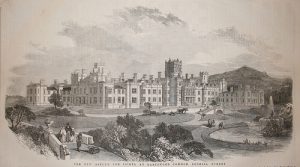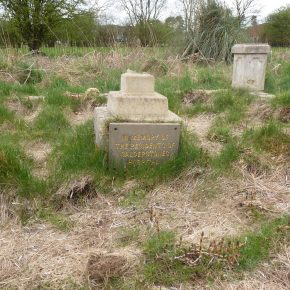 Historic deaths, difficult questions
Historic deaths, difficult questions
People with learning disabilities are more likely to die prematurely while in residential units, as was the case 100 years ago. Jan Walmsley and Pamela Dale ask if past institutional deaths, often recorded as ‘natural’, can shed light on today’s tragedies and the attitudes that can cause them
For more than 30 years, a key goal for both of us as historians has been to get closer to the lived experiences of people living with learning disabilities.
This fits with the increasingly person-centred services that gradually emerged from the closure of the long-stay institutions.
However, by concentrating on patients’ lives (Atkinson et al, 1997), we have perhaps missed the opportunity to consider their deaths and what they can tell us about care in the past. Our work exploring this topic was initially developed as a response to studies of deaths in 19thÊcentury mental health facilities. New research questions have been prompted by more recent events.
The campaigns described in the last two issues of Community Living (‘Forgotten lives commemorated’, autumn 2018, page 26; ‘Ignored and forgotten – in death as in life’, summer 2018, page 16) show that proper respect for the people buried in institutional graveyards is important. The way people are treated in death is often a vital clue to understanding the way they were treated (or mistreated) in life.
There is also a more sinister possibility we need to explore. With evidence that people using learning disability services today experience serious health inequalities and are at significant risk of premature death (Mencap, 2007; Michael, 2008; Emerson and Baines, 2010; University of Bristol; 2013; 2018), we have to ask difficult questions. Were any of the historic deaths we identified preventable? If they were, why were they assumed to be natural and not investigated as potentially suspicious? Is it possible that serious care failings were concealed? Were opportunities to protect other patients missed?
It was questions like these that underpinned the long campaign by Sara Ryan to reveal the truth about the death in 2013 of her 18-year-old son Connor Sparrowhawk (Ryan, 2017). A number of other disturbing cases were identified and, in a climate of heightened concern following events at Winterbourne View, the Care Quality Commission (CQC) decided to take the whole sector to task.
Two landmark CQC reports (2016a; 2016b) present premature deaths as both an indictment against complacent service providers and an important source of learning points for transforming care standards. This work provided a reference point for government-commissioned investigations into premature mortality conducted by the University of Bristol (2013; 2018). This official interest seems promising, although an apparent lack of urgency over implementation at a local or national level is a major concern.
When evaluating services, historians as well as practitioners need to be aware of the CQC’s worrying conclusion that ‘we found that the level of acceptance and sense of inevitability when people with a learning disability or mental illness die early is too common’ (CQC, 2016b: 2).
Just as service providers show reluctance to probe into either the nature or scale of premature deaths, so historians have been guilty of maintaining a strange silence on the subject.
While the past lives of people with learning disabilities are increasingly well documented, we still know surprisingly little about their deaths. This is not accidental. It reflects the orientation of the more influential institutional studies (Gladstone, 1996; Thomson, 1998; Wright 2001) and a reluctance on the part of institutional survivors to discuss a painful subject.
While historians have correctly identified the significant gap between the ideals of people who founded various Victorian and Edwardian asylums and the care provided, they have not pursued this discrepancy to consider questions of abuse and premature (and even sinister) deaths.
Historians of 20th century care have talked about resource scarcity and pressures on the institutions. However, there has been no appetite to dwell on specific abuses or even recount details about known scandals. Difficult issues have been minimised, with historians noting the checks and balances within the system that apparently protected UK patients from the types of sterilisation and euthanasia programmes operated by the Nazi regime in the 1930s and 1940s (Thomson, 1998).
Historical interest in the governance of institutions and the wider social, economic and political context in which they operated has generally excluded analysis of patient deaths (Thomson, 1998). This gap has not yet been filled by the work of advocacy and self-advocacy groups, which has concentrated on lived experiences and life stories (Atkinson et al, 1997; Mitchell et al, 2006).
This needs addressing. Much can be learnt from asylum historians who have made deaths central to their descriptions of patients’ lives and assessments of different clinical arrangements and governance regimes (Cherry, 2003). Although access to patient records is problematic for ethical reasons, there are sources to support investigations into deaths at local and national levels.
Death was an important topic for record keepers of 19th and 20th century asylums. It was common practice to compare monthly and annual totals and contrast death rates between facilities. This statistical analysis was often supplemented by detailed accounts of individual cases, including an assessment of the care received and praise or blame for particular staff.
Regarding mental health, historians have not only discussed deaths and death rates (Reaume, 2000) but also drawn attention to those that involved violence to the self and/or others and/or neglect by staff (Shepherd and Wright 2002; Shepherd, 2014).
We found examples of such cases among the records of the Royal Western Counties Institution, a long-stay hospital for people with learning disabilities at Starcross in Devon (held at Devon Heritage Centre).
Here, 172 patients (admitted from April 1914 to March 1939) died before the end of 1947. As non-clinicians, we can comment only briefly on the 160 or so deaths attributed to ‘natural causes’. Suspicious deaths resulted from a tractor accident, poisoning, drowning, and falls; all were deemed accidents, although some were investigated as possible suicides.
We discussed our preliminary findings with other researchers. Once prompted to consider institutional deaths, they provided testimony (based on oral histories as well as documents) relating to suspicious deaths at other facilities before and after the creation of the NHS.
Numbers of deaths suspicious enough to initiate an inquest were small. However, the total number of deaths from all causes was large. We argue historians should be first noting the fatalities – many of young people – and then asking serious questions about them.
Once we became alert to concerns about inpatient deaths, we realised there had been periodic official interest. Reports into Ely Hospital, Cardiff (HMSO 1969) flagged the issue up but drew few definite conclusions.
We suspect this gap in understanding owes more to a failure to ask questions than a genuine lack of evidence. Had Sara Ryan not pursued her son’s death with such energy, it too would have been recorded as being from ‘natural causes’, not the neglect verdict reached by the coroner.
It is time for historians to fill this gap and speak to the distinctly 21st century concern to explain and avoid premature and unnecessary deaths. We suspect far too many people have died without concern being registered and protections put in place to safeguard others.
This conclusion is not only an indictment against past services but shows a worrying, persisting legacy. Historians as well as practitioners and advocacy groups need to start to correct the neglect of this important topic.
Jan Walmsley is an independent researcher who specialises in projects related to the history of learning disabilities
Pamela Dale is an honorary fellow attached to the Centre for Medical History at the University of Exeter and a historian, who has written about institutional care
This is the last article in our three-part series on death and memorialisation in institutions
Atkinson D, Jackson M, Walmsley J (1997) Forgotten Lives: Exploring the History of Learning Disability. Kidderminster: BILD
Care Quality Commission (2016a) Southern Health NHS Foundation Trust. Quality Report. London: CQC
Care Quality Commission (2016b) Learning,Candour and Accountability. London CQC
Cherry S (2003) Mental Healthcare in Modern England: the Norfolk Lunatic Asylum/St Andrew’s Hospital, 1810-1998. Woodbridge: Boydell Press
Emerson E, Baines S (2010) Health Inequalities and People with Learning Disabilities in the UK. Learning Disability Observatory
Gladstone D (1996) The changing dynamic of institutional care: the Western Counties Idiot Asylum, 1864-1914. In: Wright D, Digby A, eds.
From Idiocy to Mental Deficiency: Historical Perspectives on People with Learning Disabilities. London: Routledge
HMSO (1969) Report of the Committee of Inquiry into Allegations of Ill-treatment of Patients and other Irregularities at the Ely Hospital, Cardiff
Mencap (2007) Death by Indifference: London: Mencap
Michael J (2008) Healthcare for All. London:Department of Health
Mitchell D, Traustadóttir R, Chapman R, Townson L, Ingham N, Ledger S, eds (2006) Exploring Experiences of Advocacy by People
with Learning Disabilities: Testimonies of Resistance. London: Jessica Kingsley
Reaume G (2000) Remembrance of Patients Past: Patient Life at the Toronto Hospital for the Insane, 1870-1940. Don Mills, Ontario:
Oxford University Press Canada
Ryan S (2017) Justice for LB. London: JKP
Shepherd A (2014) Institutionalizing the Insane in Nineteenth-Century England. London: Pickering and Chatto
Shepherd A, Wright D (2002) Madness, suicide and the Victorian asylum: attempted selfmurder in the age of non-restraint. Medical
History 46: 175-96
Thomson M (1998) The Problem of Mental Deficiency: Eugenics, Democracy, and Social Policy in Britain c1870-1959. Oxford:Clarendon Press
University of Bristol (2013) Confidential Inquiryinto Premature Deaths of People with Learning Disabilities (CIPOLD)
University of Bristol (2018) Confidential Inquiryinto Premature Deaths of People with Learning Disabilities (LeDeR)
Walmsley J, Welshman J (2006) Introduction. In: Community Care in Perspective: Care, Control and Citizenship. Basingstoke: Palgrave Macmillan
Wright D (2001) Mental Disability in Victorian England: the Earlswood Asylum 1847-1901. Oxford: Clarendon Press

